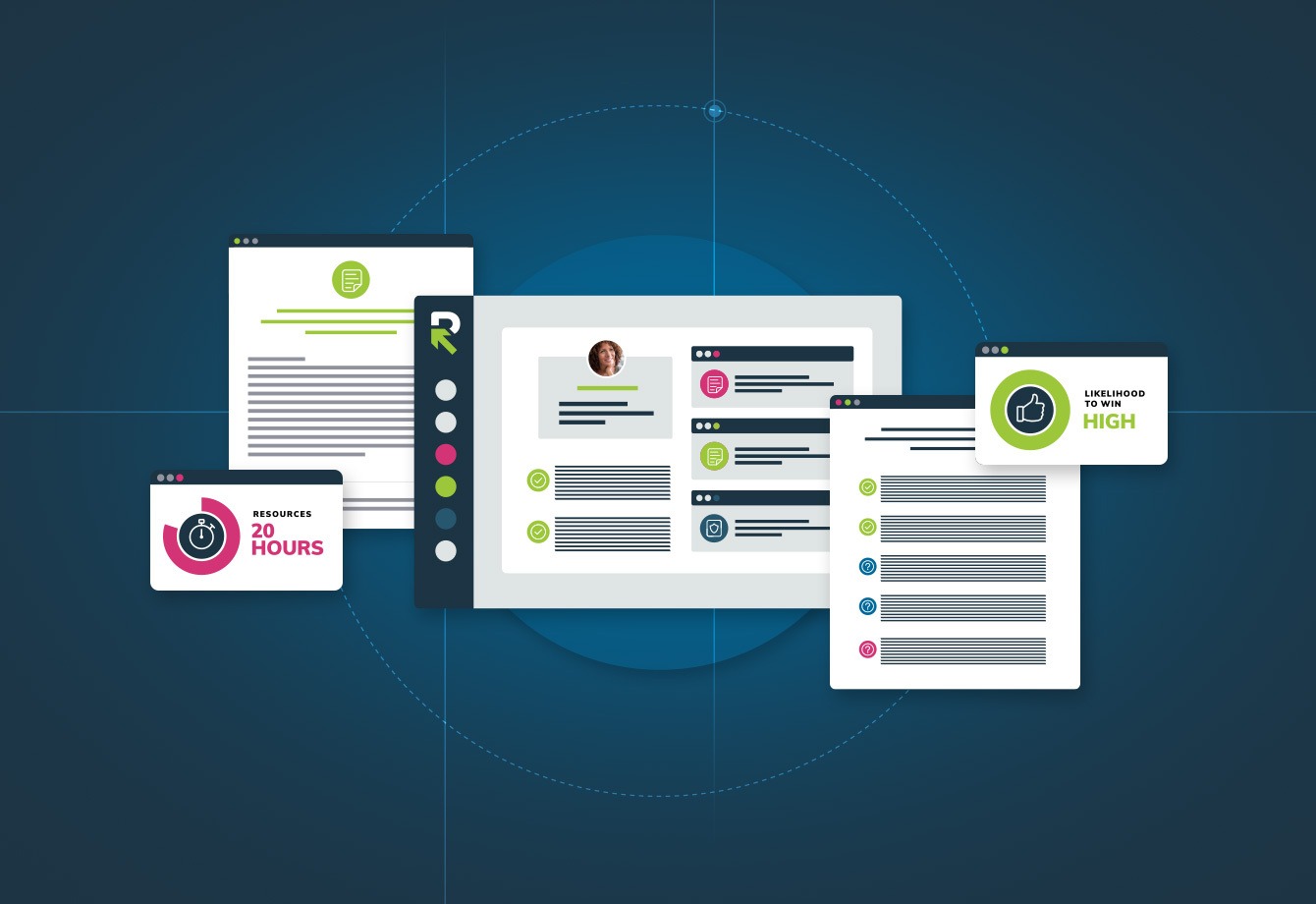If your company is like most, you responded to a lot more RFPs last year than you did the year before. You’ll likely respond to even more in the upcoming months and years.
Leadership is beginning to understand the importance of dedicated response professionals. Still, they’re a bit more reluctant to invest in the processes needed for efficiency, faster response times, better morale, and higher win rates.
To be fair, not all RFP response processes call for automation or even computers, but unless you’re a one-person show–and even if you are—creating quality, on time responses requires a repeatable process. Here is what that looks like for us and perhaps for you.
The basics of the RFP response process
When a company or organization wants to make a major purchase or launch a project, they usually issue a detailed document–a request for proposal (RFP)—describing their needs to several potential vendors. A typical RFP will outline the following:
- Their budget for the project or product
- The project’s goals
- Common deal-breakers, such as:
- Unsatisfactory audit findings
- Insufficient security protocols
- Poorly-defined procedures and policies
- Improperly vetted subcontractors
- Customer support concerns
- Inability to meet the buyer’s budget or timeline
- Not enough customer references
- No out-of-the-box functionality
- The most important factors
- The RFP’s due date
The prospect may also include separate documents such as a security questionnaire, which asks about your and third-party vendors’ security protocols, or due diligence questionnaire, which asks about your company rather than your product.
The best way to produce a winning bid is to have a process in place. Do you have project management software? Who is your project manager? Do you have a list of subject matter experts (SMEs) and their schedules? What about other stakeholders, such as writers and editors?
RFPs are more alike than they are different. Around 80 percent of an RFP’s questions are relatively standard. For example, it’s common for an RFP to ask about company history, hiring practices, and the onboarding process. Why not have those answers ready to go or at least prepared for a quick proofread?
Creating a repeatable process establishes:
- Whether the RFP is worth pursuing
- Team participants
- Timelines
- Role definitions
- SME engagement
- Final evaluation
Why are RFPs issued?
Organizations issue RFPs when their needs are complex and want to efficiently access multiple vendors. Governmental organizations, many nonprofits, and large companies send RFPs for every purchase exceeding a certain threshold.
Steps in the RFP response process
Establishing an effective and efficient process is easier than you might think. RFPIO’s response managers have identified eight steps:
Step 1 – Go/no-go
As the number of RFPs you receive increases, so does the number of questions on each one. Instead of attempting to respond to each one, choose those that best align with your business and are winnable.
Step 2 – Have a kickoff party
Unfortunately, most kickoff parties don’t have cake, but they do define team and individual roles, responsibilities, and objectives.
Step 3 – 1st draft
Because roughly 80 percent of an RFP contains questions you’ve probably answered before—many times—let your automated system take a run at it first. Make sure the answers are correct and up-to-date.
Step 4 – 2nd draft
Consult with SMEs and other stakeholders to answer the remaining questions.
Step 5 – Review and revise
Were the questions answered accurately and completely? Were all the objectives met? Are there any misspelled words or typos? Are the responses otherwise well-written? Have you attached all relevant documents?
Step 6 – Submit
Once you’ve completed and polished the response, submit it (hopefully before it’s due). Confirm that it was received and let team members know.
Step 7 – Save and audit the responses
Every answer is potentially valuable for future RFPs. Save them in a central location that’s easily accessible to key stakeholders. Make sure you regularly audit the content in the centralized repository.
Step 8 – Postmortem
Win or lose, every response is a learning opportunity. What worked? What could have used improvement?
An example of a high-quality RFP process
A high-quality process is well-defined, efficient, and generates quality proposals for winnable RFPs. Once you’ve established a high-quality process, your team will begin to run like a well-oiled machine, you’ll increase the number of responses and hopefully win more bids.
Accruent, a Software-as-a-Service (SaaS) company, has recently acquired several companies with highly-technical products. RFPs began arriving faster than the response team could master the new technologies. Unsurprisingly, SMEs were stretched thin.
Accruent introduced RFPIO into their response process. Confident that their answers would be stored for future use in their Content Library, SMEs were much more likely to offer their expertise.
Soon, because more than 75 percent of answers came directly from the Content Library, the response team more than tripled its capacity.
RFP response process metrics
The go/no-go step is key to increasing your win rate, but knowing which RFPs to answer requires data. Tracking metrics should be part of your response process. Those metrics include the following:
- Project types – How many RFPs did you answer compared to DDQs and other documents?
- Types of wins – You should save your resources for winnable RFPs. What kinds of projects provide the highest win rates? Break types down by:
- Vertical – Are there specific industries that are more apt to purchase your product or service?
- Company size – Are your target customers enterprise-level or small and medium-sized businesses?
- Product line – What is your win rate for that product?
- Project type – Has your company successfully implemented this type of project in the past?
- Project stage – How far do similar projects make it through the sales funnel?
- Number of questions – Do you have the bandwidth for an RFP of that size?
- Project value – Is it worth it for you?
- Project scope – How much work does your current project require?
- Completion time – How long does it take, on average, to complete a similar project? What is the shortest time on record, and what is the longest?
- Average response rate – What percentage of incoming RFPs do you answer?
- Resource needs – Comparing the content and moderation needs, who are the people who are best suited for the project?
- Content needed – Read and understand the questions and determine how much content you have in your Content Library.
Once you have decided to go forward, metrics help keep you on track and tell you whether it’s worth continuing.
- Determine workload – Break down the project into manageable deliverables which can be divided among your team.
- Readability score – Write in a way that’s easy to understand, typically at no more than a 10th-grade level. Use tools like the Hemingway App or Flesch reading ease test to ensure readability.
- The Probability of Win Score (PWIN) – You’ve already calculated your odds of winning based on past similar projects. Still, the PWIN examines the details of your current project for a more accurate prediction.
- How do your answers compare to similar RFPs that you’ve won?
- Have you answered each question?
- Have you met all the conditions?
- How many questions were you able to answer in the affirmative?
- Identify content gaps – What is missing from your Content Library? What needs to be updated?
- Determine your Content Library’s health – How many questions can you answer using the curated content in the Content Library? Aim for 40-80 percent.
For more information on response metrics, read here.
Best practices for a smarter RFP process
Turning your RFP process into an 800-horsepower revenue-generating engine takes coordination, a great pit crew (so to speak), and tools to turbocharge efficiency.
At RFPIO, we receive and respond to RFPs just like you. Below are the best practices our experts swear by.
Encourage collaboration
A Facebook poll by RFPIO found that effective collaboration was considered much more important than an efficient process. I would argue that neither is possible without the other.
Because RFPs are long, complex, and require potential input from every department, from finance to HR to IT (and more), collaboration is a critical part of an RFP response process. And because we have distributed and siloed workforces, intense competition for SMEs’ time, and tight deadlines, smart processes foster collaboration.
An RFP response system should leverage project management and communication tools to keep everyone on the same page. And because respecting your colleagues’ time is key to continued collaboration, it should also include a single source of truth knowledge management system to record answers for use on future projects.
Bring effective storytelling into your RFP responses
No one is suggesting that your RFP response should include the next great novel, but telling your organization’s story helps make your response memorable and builds trust among readers.
Your proposal’s story should include information about your company, such as why your founders created your solution, how it will meet the customer’s needs, and how you will handle their needs.
Your cover letter might highlight your company’s values and what it does to live up to them. It’s also a great idea to include testimonials from customers with similar needs.
Automate your response process
At least three-quarters of companies hope to boost their RFP response, but only around half of those companies consider increasing response staffing. That leaves one option, which is to automate their response processes.
Because most questions on an RFP are exact or near exact duplicates of former queries, you can save hours, days, or even weeks by leveraging machine learning to access those repeat question-and-answer pairs, giving you the time to address the questions that need your efforts.
Develop habits that support organizational success
Suppose you worked out or ate well today. Congratulations! Continue for a few weeks, and the next thing you know, you’ll have formed a habit that might lead to better health and longer life.
When you habitually maintain your list of SMEs and other stakeholders, as well as your Content Library’s health, those habits will pay off with faster responses, smoother collaboration, and improved morale.
Enable your sales team
Aside from your employees, a well-maintained single source of truth is your company’s greatest asset. It might contain incorporation papers, financial statements, sales reports, and product details. There’s no limit to the number of use cases.
We like to think of RFPIO as a sales enablement platform. Naturally, RFPs generate tremendous revenue. Still, a well-maintained Content Library supplies relevant, customer-facing information for sales teams with a few keystrokes. RFPIO’s proposal management features can help you create winning sales proposals complete with automation and reporting.
And because salespeople spend time on the road, RFPIO® LookUp provides access to your Content Library from anywhere you have browser access.
The role of RFP software
Chances are, your company uses CRMs and other sales enablement platforms. You probably also use communication apps and some sort of project management software. How does one make a case for more on top of what your CIO might call a bloated tech stack?
Advanced RFP software works with your tech stack, not on top of it. It should integrate with your productivity, communication, and sales enablement apps, but it should also add value on its own. Unlike a standard project management platform, RFP software is customized for proposal management.
RFP software is designed to let you respond to more requests and maximize your win rate. It may not be a specific part of your sales team, but like your top salespeople, its superpower is revenue generation.
Advanced RFP software should import and export from and to nearly every format and offer standard and customizable templates. Its knowledge and document library should provide relevant stored Q&A pairs as well as required documentation with a few keystrokes. In fact, its knowledge and document library should serve as a single source of truth for the entire organization.
The software’s reporting features should go far beyond response analytics and help facilitate informed business decisions. Additionally, because RFPs come in waves, software should be scalable and instantly respond to your changing requirements.
Choosing the right RFP software for your team
I could spend hours highlighting all the RFP software features you might need, but the fact is that even you don’t know what might arrive next week and especially next year. Your ideal RFP response solution is a bespoke answer to your evolving needs.
The software should work with your existing systems to maximize revenue and efficiency. It should be designed by response managers who know the ebbs and flows of response processes.
The most important feature, however, is the designers. Is the company receptive to your questions and poised to consider adding features as requested?
RFPIO’s approach to the response process
RFPIO offers an end-to-end approach to RFP response. Its features include:
- Knowledge – Store your commonly-seen questions and answers and your critical documents in a single repository.
- Collaboration – Communicate with other stakeholders inside the platform or with your current collaboration apps.
- Projects – Break your projects down into manageable pieces, assign tasks, and keep track right inside the app.
- Insights – How much time and other resources are you using? How many and what kind of deals do you win? What are your strengths and weaknesses? RFPIO has many standard and nearly unlimited customized reporting features.
- Integrations – RFPIO integrations work seamlessly with more than two dozen of the most popular business applications.
- Remote access – RFPIO® LookUp provides access to your Content Library through Google, Microsoft Office, and many other applications.
- Loyal customers – RFPIO is the response platform for many of the world’s most successful companies, including Google, Microsoft, Facebook, Visa, Lyft, Zoom, and hundreds more. Read more about RFPIO from our customers.
Case study
While RFPIO is the RFP response solution for large companies, most enterprise organizations have dedicated response departments. Employees for smaller companies find themselves wearing many hats, which sometimes means putting RFPs on the back burner.
Complí, a small software company located in Portland, OR, often found themselves missing deadlines for lack of time and personnel. Just a week after investing in RFPIO, that changed. The company was able to respond to RFPs without holding time-consuming, in-office meetings. They were also able to complete up to 80 percent of each RFP with just one click, thanks to the Content Library.
Today, they are submitting RFPs on–time (and even early) and the entire company uses the Content Library as their single source of truth.
RFP response management process FAQs
It isn’t easy to gauge RFPIO’s true value without seeing it in action. We invite you to view a demo to see how RFPIO might benefit your organization. Before that, though, here are some of the most common questions we are asked:
- What is an RFP? – A request for proposal (RFP) is a document designed to solicit multiple bids for large organizational purchases.
- What type of information and questions are included in an RFP? – An RFP provides in-depth descriptions of the customer needs, deadlines, and so on. It might ask for company history and details, pricing, related past projects, and projected deliverables, and so on.
- Why do organizations issue RFPs? – Organizations issue RFPs to gather pricing and service comparisons in their desired formats.
- Who responds to RFPs? – Some organizations have dedicated response departments. Others might respond through their sales teams.
- What does RFP software do? – The short version is that RFP software helps organizations win more business using fewer resources. The longer version is that it utilizes your existing applications and teams, along with customizable tools and a robust Content Library, to become a revenue-generating engine.
- Does RFPIO do more than respond to RFPs? – As a response platform, RFPIO will automatically respond to up to 80 percent of a request for information (RFI), request for quote (RFQ), security questionnaire, due diligence questionnaire, and more. As a sales-enablement tool, its proposal management features and Content Library will help you drive revenue. And as a business application, its built-in and customizable analytics will provide the information needed for informed decision-making.
- Does RFPIO integrate with existing applications? – RFPIO integrates with more than two dozen applications, including the most popular ones.
- What if we need to add or subtract users? – RFPIO has a best-in-class pricing model. Instead of purchasing licenses, we provide unlimited access.
- Is RFPIO secure? – RFPIO has industry-leading security protocols. We are trusted by the world’s leading technology, healthcare, and financial services companies, including Google, Facebook, Microsoft, Visa, Cigna, and far more.



